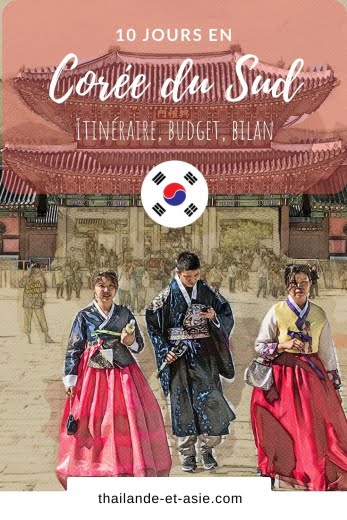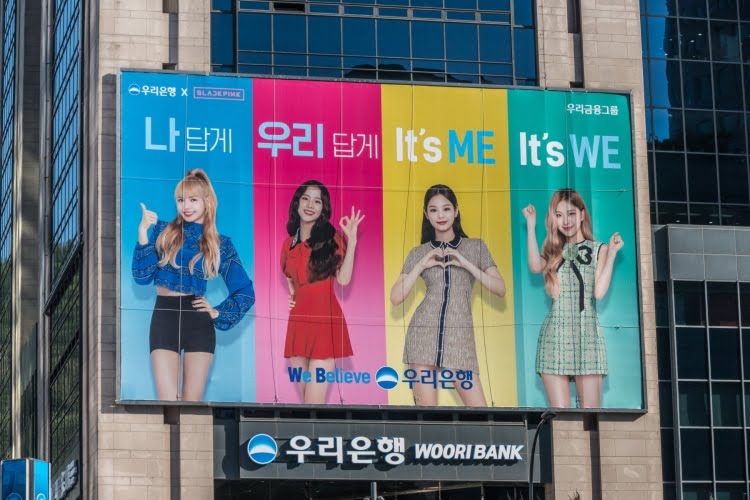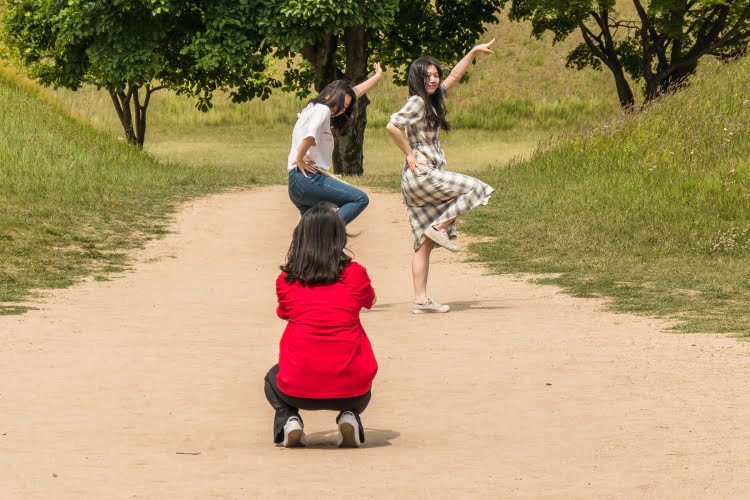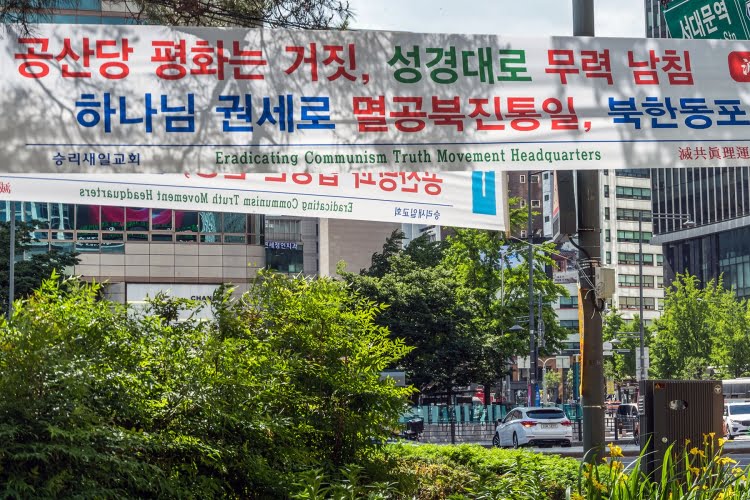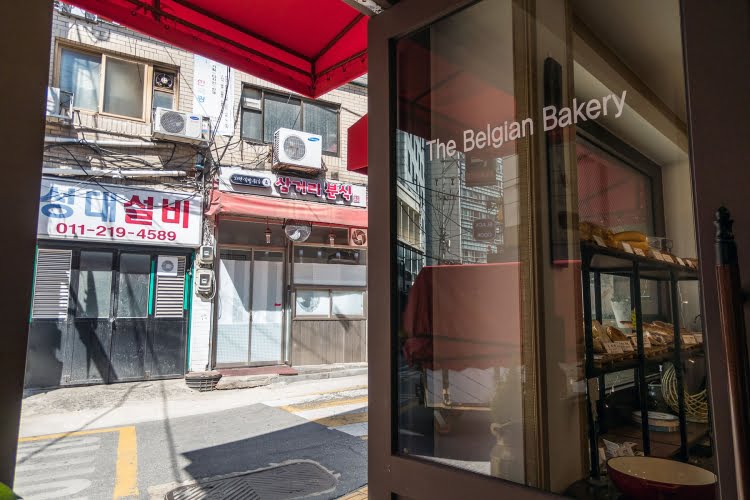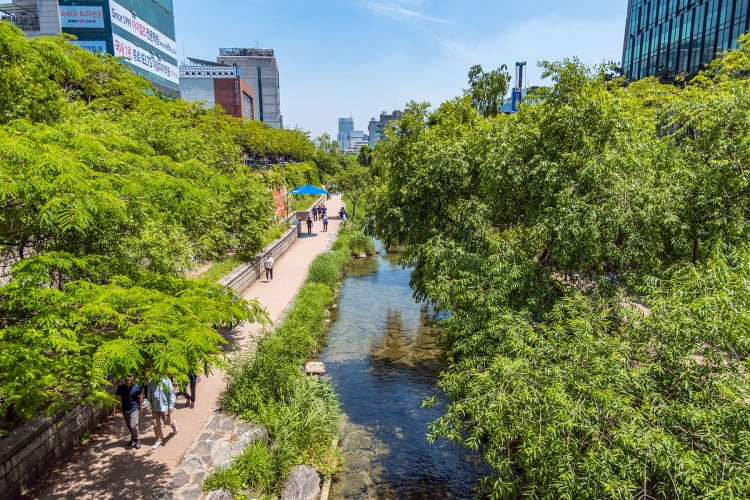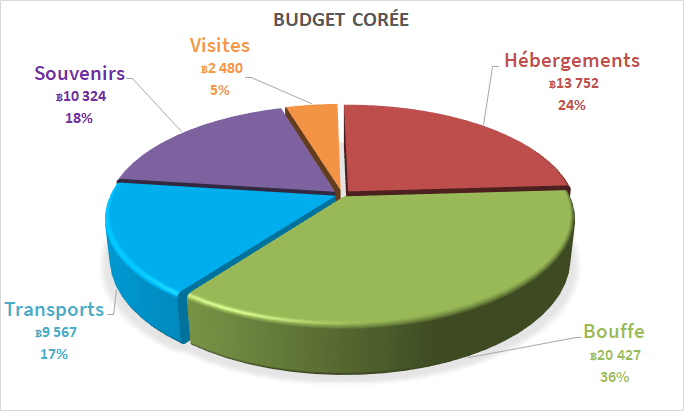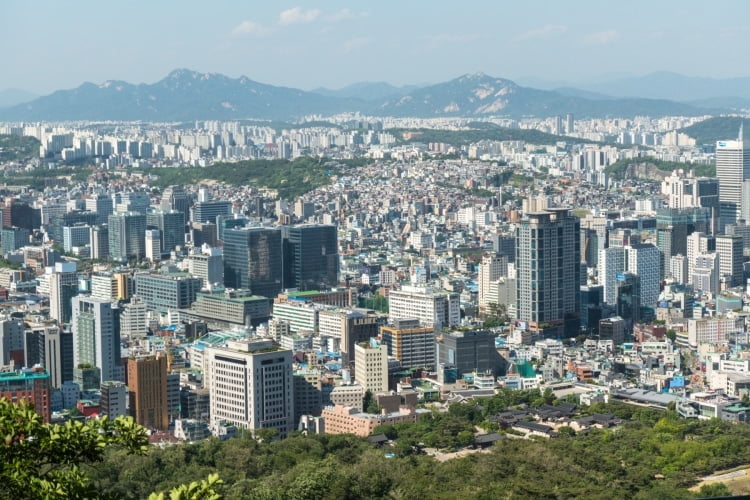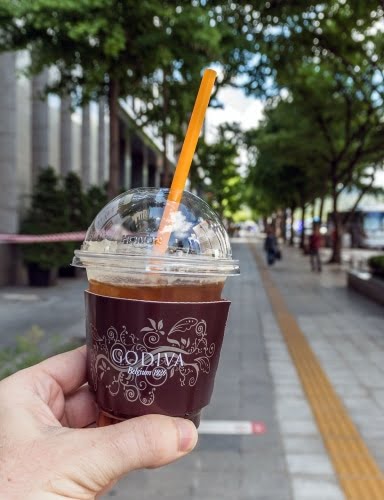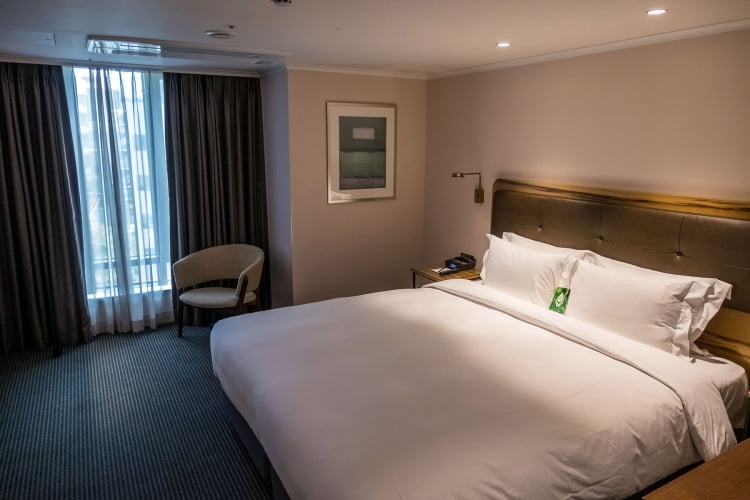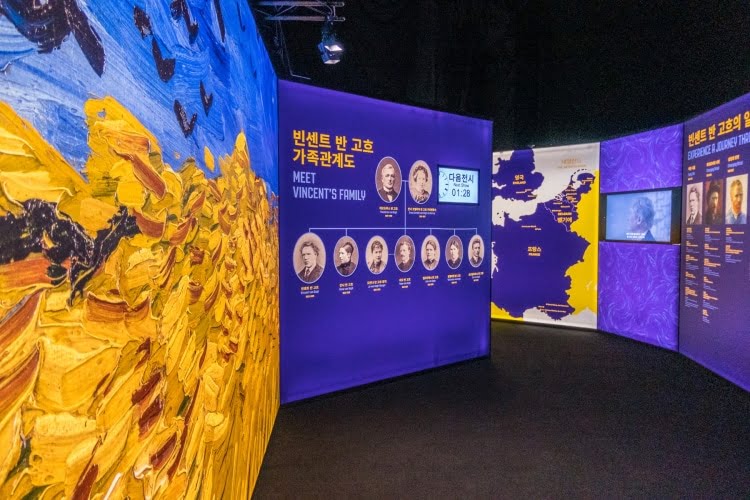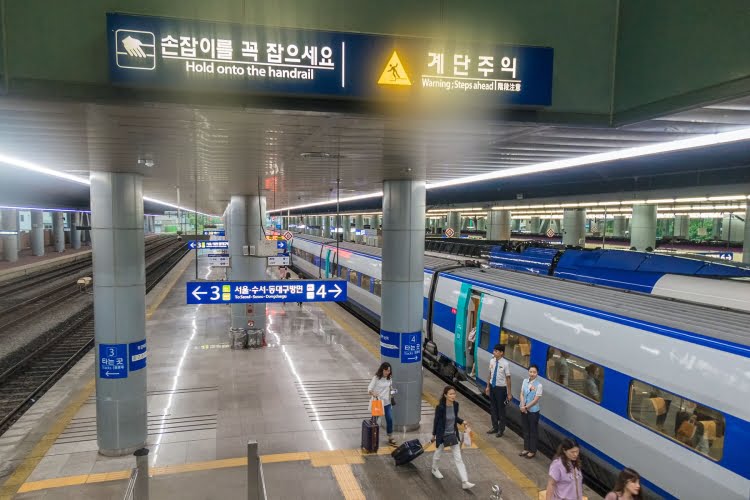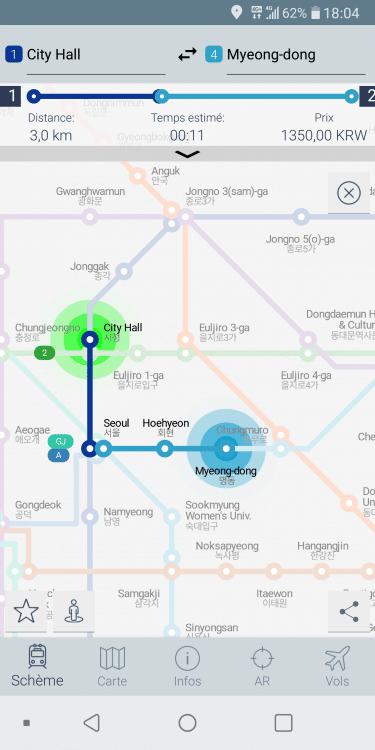
It so happened that we visited the "enemy brothers" in two consecutive years, since after our stay in Japan, it was in South Korea that we were going.
It wasn't a country on my "list" at the base, in any case, not a priority, but wanting a destination that didn't require too much of a day to get a good overview, and by looking at the plane ticket promotions, we came across interesting prices for a Bangkok - Seoul flight.
So I thought, why not. Even if we only had 10 days, we decided to go from north to south, from Seoul to Busan. A visit that is certainly quite brief, but allows you to have a good overview of what it can give in terms of experience in this country neighboring Japan.
Here I give you a brief summary and share with you my itinerary, my impressions and the budget for this first glimpse of the land of the calm morning.
In the land of K-Pop
Korea is quite popular with Thais and many Southeast Asian countries, because between the famous Boy Bands and Girl groups too, there is enough to make hearts flutter. Some people travel just to see them in concert. Obviously none of that for us, focusing our stay on art and especially history.
South Korea tends to be overshadowed by its neighbor Japan in terms of appeal. The country sounds like a pale Japanese copy, with a culture deemed bland. Let's not lie, there are similarities, but with the mix of Chinese culture, South Korea definitely has its own identity.
As proof, I want to point out that before 2015 (so recently anyway), South Korea welcomed more tourists than Japan! Even I was surprised. The two countries then had similar numbers around 13 million visitors. But recently, Japan has managed to pull through, tripling the number of tourists since 2013 (more than 30 million visitors last year in Japan), while South Korea is "stagnating", with only 15 million in 2018.
Welcome to South Korea
In terms of the welcome in the country, it is not easy to judge in such a short time with relatively few interactions. What I take away from it is that English is not particularly spoken, except in hotels obviously. Restaurants generally have a menu subtitled in Latin alphabet but if this is not the case, images are generally there to help you choose.
Overall, we feel welcomed, people are quite friendly, more so than I expected. At "worst case", we are just considered as an average person in the end, tourist or not, Korean or not.
I was warned that in terms of portrait photos it would not be like in South-East Asia so I avoided doing any. But I did not feel too much distrust in this regard, only once a lady called out to me asking if I had taken a photo of her (while I was taking the street), reassuring her, and it was true, that it was not the case (I was aiming higher so there was no one in the field.
On the other hand, they love taking pictures of themselves, already in Thailand it goes there, it's almost a national sport. And forget the Korean who forms a heart with his arms above his head, the new fashion is to do it with the fingers, crossing the thumb and index finger.
If you are curious like me, I will put an article for you to understand the origin, but sorry, I found that in English:
It's still quite lively, we saw some lively neighborhoods in the evening where people drink around a famous Korean BBQ, and others, conducive to relaxing in nice cafes, each with a different look but always making you want to take a breather and stock up on caffeine.
In terms of visits, let's say that there was a redundant side to the temples and many are in fact reconstructions, between the Korean War and the fires of various origins, it suffered quite a bit... And that's precisely what can be felt, the country is still divided, some are still resentful towards their northern neighbor and can't get over the idea of having a part of their communist country. We came across several demonstrations to that effect, it was always a bit weird.
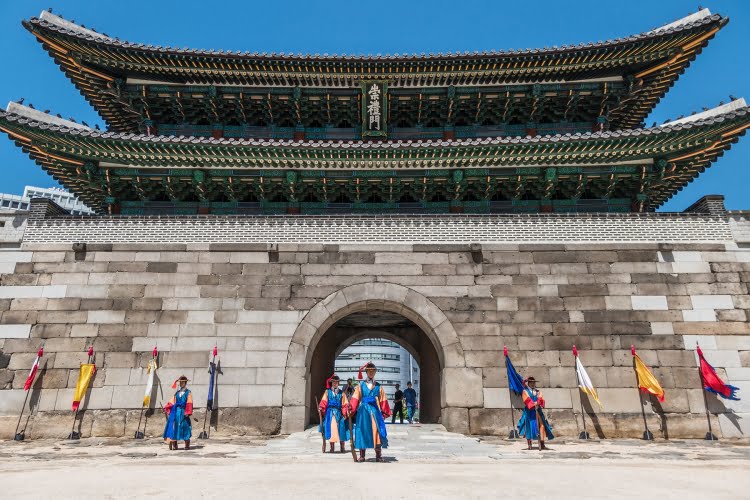
The Sungnyemun (Namdaemun) fortified gate and its guards, in Seoul.
If I have to make a concrete assessment, I would say that it remains a pleasant visit and that it is still likely that we will return to this country, even if it is just to visit the island of Jeju.
Korean cuisine
I'm not a big fan of Korean food but I still enjoy going there from time to time in Bangkok... The thing is, often foreign cuisine is adapted to local tastes. This means that I was finally discovering what Korean food is really like.
Not eating shellfish or seafood in general, I admit that I was quickly limited in my choice of dishes. I was not particularly impressed and it cannot be said that it is for me a strong point of the country. Afterwards, I want to say that "tastes and colors", eh, don't throw stones at me. I'm not saying that it was bad either, just that well, kimchi here, kimchi there, it lacked variety for my taste.
On the contrary, in her own words, Jitima had a great time, because she and seafood make four! And she loves kimchi too.
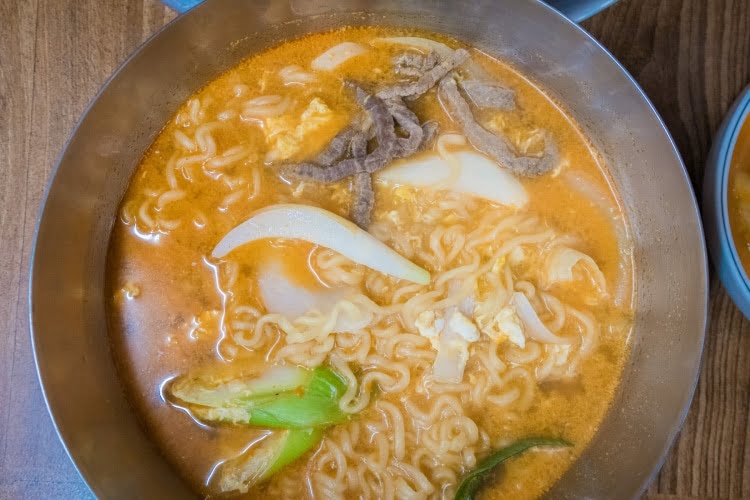

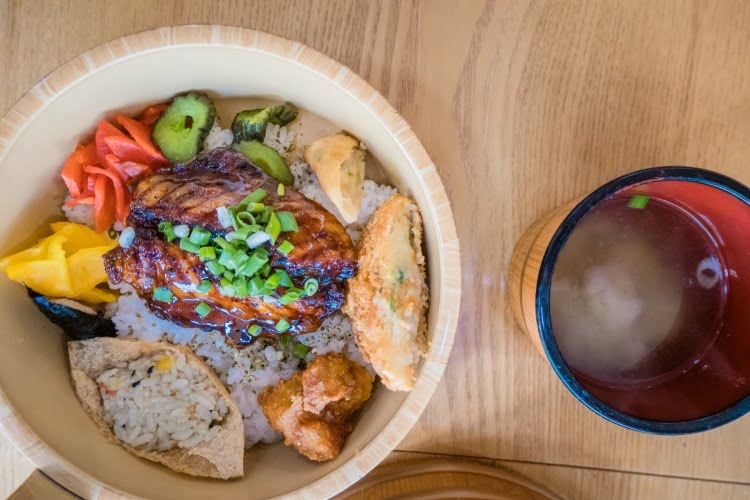
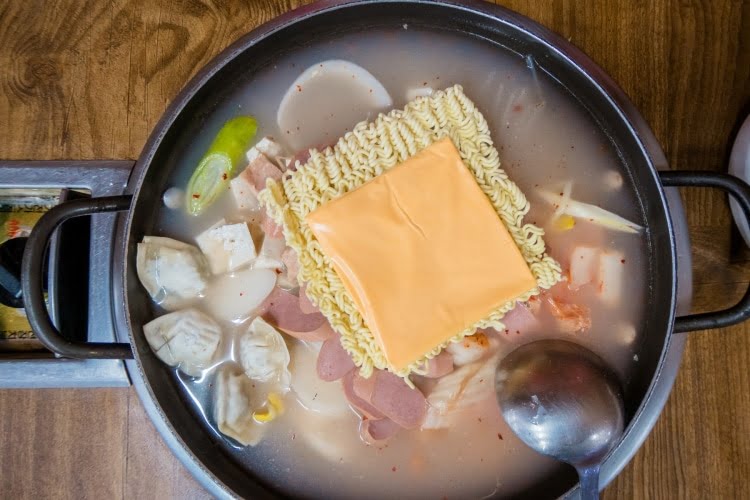
It's still essentially based on rice and noodles, so it doesn't change much from my daily life, even if the flavors are completely different. Unlike in Japan, it was classic in the way it worked in the sense that we didn't have terminals everywhere. We ordered via a waiter/waitress and paid at the cash register. Just a few times where the system was similar to a self-service restaurant since we had to get the dish from the counter when it was ready and bring the dirty dishes back to the appropriate place.
I also tried a few bakeries, one in particular that was very good, while we were going towards the Seoul Tower, a nice surprise since it was very small and unremarkable.
10 days in South Korea: our itinerary
We spent almost half of our stay in Seoul. Firstly because there are a lot of things to see but also because we didn't want to waste too much time on transport. Well I say that, the country is not excessively large and with their express train, we get around rather quickly. But it still depends on the axes, and once there, we wanted to avoid having to rent a car or something else so we tried to keep it simple.
An example in this sense, originally, we planned to go to Jeju Island, but that would have required at least 2 or even 3 additional days. The latter is still 80 km long and almost deserves a stay dedicated to it alone, not to mention the additional budget that would have had to be taken into account in this case.
Here is the itinerary taken for this first stay in South Korea:
- Early arrival in Seoul – Cheonggyecheon Greenway – Gyeongbokgung Grand Royal Palace – Myeongdong
- Seoul – Deoksugung Palace – Seoul Tower
- Seoul -> Andong
- Hahoe Village -> Gyeongju
- Gyeongju
- Gyeongju -> Busan
- Busan – Gamcheon Culture Village – Jagalchi Market
- Busan -> Seoul
- Seoul – Changgyeonggung Palace – Bukchon Hanok Village
- Seoul – Jongmyo Shrine – Gangnam – Banpo Hangang Park (then return flight late in the evening)
This route was created using the site The Travel Planner
When I said that we focused on history, it is quite explicit in our journey. Well, the capital to start with, essential like practically any country, with its royal palaces and its districts with old houses. But also its shopping districts like Myeongdong, where the mythical Gangnam district.
Seoul has this advantage of mixing the old and the modern very well. And on the modern level, I dream that a project similar to the Cheonggyecheon Green Belt was born in Bangkok, really pleasant and enjoyable to walk along, to the sound of the clean stream that flows in its middle (even if the latter was already there before, I say modern, because it is a reconstruction in the end).
This first part was only a preview since we planned to stop again in Seoul on the way back to complete our visits, as we have to go back there anyway to return to Bangkok.
For the rest, we therefore mainly went to historically important or ancient places such as Hahoe village, from where we were going since the small town of Andong. The next step was Gyeongju, ancient capital during the Silla Kingdom, that is, for more than 1 years. It is therefore a real open-air museum that easily requires two or three days of exploration.
Finally, we ended our journey in the south, in Busan, which was intended to be the "nature" destination of this stay. Well, nature... That's because Busan is by the sea, so with beaches and some possible walks along its literal. After that it remains a very big city and we will therefore have essentially had an itinerary centered on cities or urban places, even if it is still very largely surrounded by nature in general, because there are always small mountains on the horizon in Korea, it is very hilly.
Luckily, we happened to be there during the sand festival which takes place on Haeundae Beach, with the theme of music concerning sand sculptures. It is a very popular festival in Korea that attracts a lot of people so it was very lively with live concerts, entertainment and fireworks. Too bad for them and for us as the bad weather invited itself during our 2nd day there (which was supposed to be the last of the festival).
On our way back to Seoul, we finished our visits while returning to the places we had liked the first time. I'm thinking of the Myeongdong district, but also along the Cheonggyecheon promenade. We had also chosen to test a new district to sleep in, originally to be closer to the sites we had planned to visit on this return to Seoul. This turned out to be a wise choice, because it was lively at night and full of charm during the day. We took the opportunity to do the last souvenir shopping, Jitima, by chance, found what she wanted to do her watercolor paintings while we came across THE district clearly dedicated to artists.
Budget for 10 days in South Korea
Let's not lie to ourselves, Korea (South) is not cheap. We are in a similar price range to Japan, and comparable to Europe, still more affordable regarding accommodation.
I already mentioned it in my article on Japan, I want to re-specify it, as the years go by, we are no longer on a correct budget, abandoning a little the "backpack" mode so not too many hostels with shared bathrooms for us in general. This is also why we recently allow ourselves destinations like Japan or Korea (it does not prevent me personally from continuing to travel around Southeast Asia more haphazardly, let's say that each country tends to make us travel differently).
This budget only reflects our way of traveling and should be taken as an indication rather than a model.
Budget on site: 43 ฿ (132 €) or 1 ฿ (268 €) / day for 4, very similar to Japan's budget and not a surprise at all. A little clarification though, if you are curious and go take a look at the budget for japan, you will see a slightly higher figure (43 ฿) but a lower amount in euros (786 €). The reason being that the baht has been rising for several months and its value is around 1 baht for 152 euro these days compared to 34 during our stay in Japan last year.
Brought back to the 2018 value, this is equivalent to a budget of €1 on site, and this for 135 days and not 10 as for Japan. In summary, we therefore spent slightly less compared to Japan by around 9%.
Regarding accommodation, we paid 13 ฿ for 752 nights, paid in advance because we had fixed our itinerary, which makes a budget of 9 ฿.
Total Budget: 56 ฿ (884 €) or a little less than 1 € per day per person.
Add to that our plane tickets, which we had a very good price for thanks to Air Asia. For a Bangkok – Incheon, we paid 17 ฿ for 500 (or €2 per person) round trip, which is about 240% cheaper than for Japan.
After these 2 consecutive trips with fairly substantial budgets (especially for us, because we don't have the same salaries proportional to Europe!), I think we should calm down a little next time.
Afterwards it is obvious that we could simply reduce our budget. If we take into account that the souvenir budget is 10 ฿, which is still 324%, it is not as such essential for the trip.
Another notable point is the food, at 20 ฿, it's more than 1/3 of the total budget ! So not that it's excessively expensive, even if overall it's not particularly cheap either, but we treated ourselves. In addition to the systematic snacking, we both drink coffee, our guilty pleasure. To give an idea of the magnitude, our caffeine budget was 3 ฿, which is still 850% of the “food” budget, which is not essential either.
Well in the lot, it still includes some cakes and not just drinks, even if I can estimate the only one dessert budget around 3 ฿ or about 16%, which therefore makes a coffee/dessert budget of 35% of the total and ultimately leaves a budget for breakfast (not always included in hotels), lunch and dinner of about 60%, the remaining 5% being water, also essential.
As I mentioned above, the accommodation budget is reasonable, with a average of 1 ฿ (528 €)/day, yet in a single room and private bathroom. Afterwards they were certainly small rooms overall but rather good value for money.
The visits are for many either free or relatively cheap, and this, whatever your nationality (here no need for double pricing like most countries in Southeast Asia, often charging 3x or even 10x more to foreigners than to locals). In Seoul, we benefited from a combined ticket allowing the visit of the 5 Royal Palaces for just ₩10 per person, or just €7,6.
And also knowing that passing in front, Jitima wanted to see an exhibition concerning Van Gogh (Meet Vincent Van Gogh, which takes place in Seoul and Barcelona) which added 16 ₩ per person (000 €), the most expensive entrance ticket we paid during the whole trip and represents 12% of the total budget for the visits.
Finally, regarding transportation, we only used public transportation. In the city, it was mainly the metro and possibly buses, with which we used our T Money prepaid card, very convenient. For longer journeys, it was mainly with the intercity train. So it is not the most expensive in Korea, knowing that out of the total 9 567, a good third are due to the return train to Seoul from Busan (3 ฿, or 348% of the transport budget alone!).
Some pointers:
- A 500ml bottle of water costs an average of 800 won (€0,6)
- A meal costs an average of 23 won per person (€000)
- Subway: an average trip costs 1 won (€350)
- Average price for tours: 3 won (€500)
Getting around in Korea
Seoul has a good subway network, with 22 lines totaling 330 km, we are able to travel anywhere in the center and the surrounding area. Incheon Airport itself is accessible both by train and by subway, knowing that there are 60 km separating the international airport from the center of Seoul. We were also testing both methods. The express train on the way there (2 ₩ per person) which is direct and takes about 18 min, allowed us to get into the swing of things more quickly, while on the way back, we went there by subway.
With all the stops involved, it roughly doubles the travel time (1h30), but the cost is around 4 ₩ (depending on your exact departure station in Seoul). From the start, we had taken a rechargeable T Money card, easy to recharge at the terminals found at all stations. Practical, it avoids looking for change and you can pay for both the subway and the buses, both in Seoul and in Busan.
For intermediate journeys, we mostly took the bus, such as between Andong and Hahoe village (19 km), Andong to Gyeongju then between Gyeongju and Busan. On site in Gyeongju we took buses the first day to visit the most distant sites and we rented bicycles the 2nd day.
Busan being a big city, it has a subway with 4 lines covering 116 km. The bus is also suitable if there are no stations near the place of visit (I am thinking in particular of Colorful Gamcheon Village on one side of the city and on the Haedong Yonggungsa Temple on the other).
To help me get around, I had planned a few applications on my smartphone (on Android, sorry Mac friends), which proved very useful:
- South Korea Map Offline, detailed, with visible bus stops and metro entrances, it helped me a lot, combined with GPS, to get my bearings.
- Seoul Subway Guide and Interactive Map, simple and effective to know which lines to take and the stops for connections, it also indicates the estimated time, distance and fare and all in French.
- Busan Metro Guide and Interactive Map, same as above for Busan city.
They are all accessible offline, because I did not consider it necessary to take a local SIM card. Especially since we also regularly had free Wi-Fi in public areas (metro stations etc.)
South Korea in pictures
A small photo gallery to give an overview of this trip.
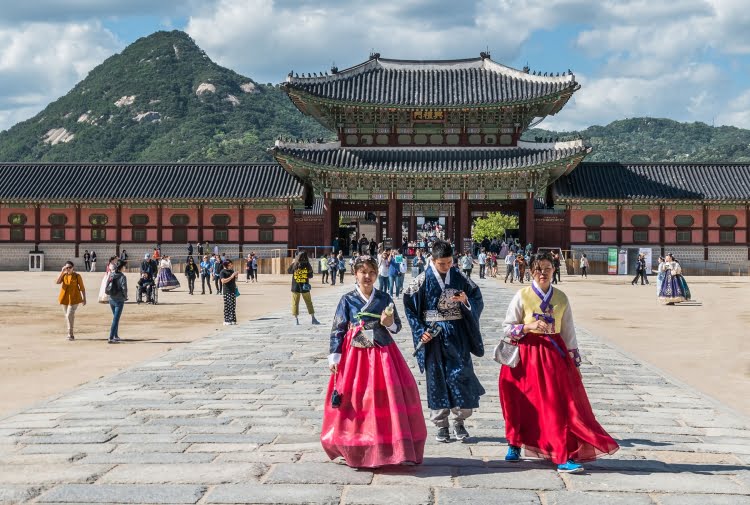

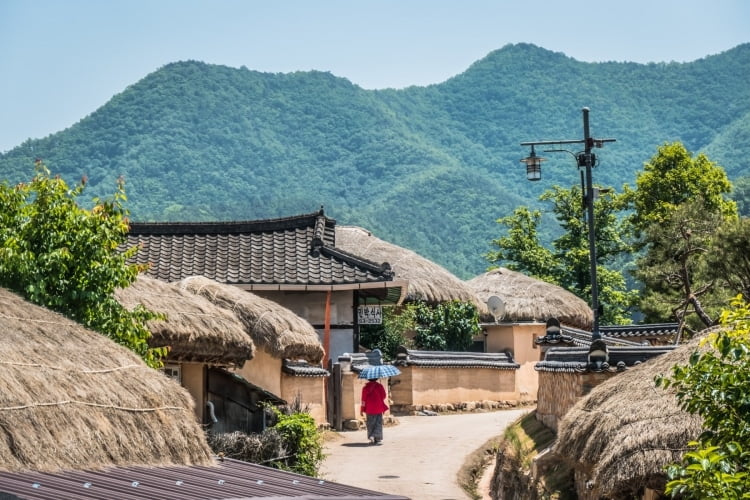
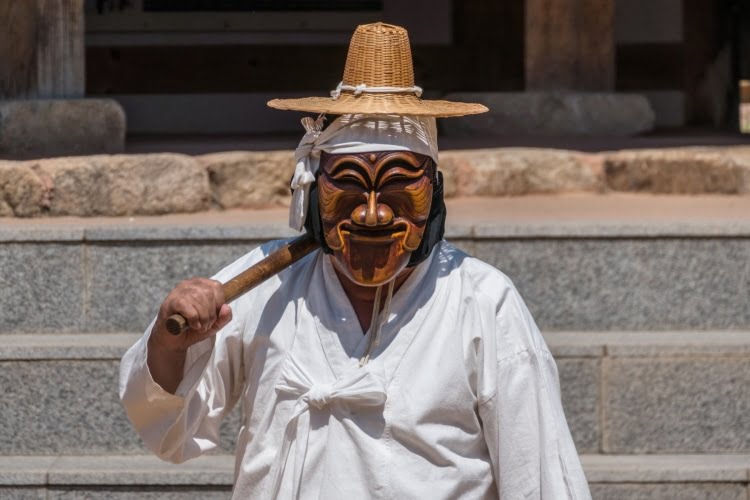
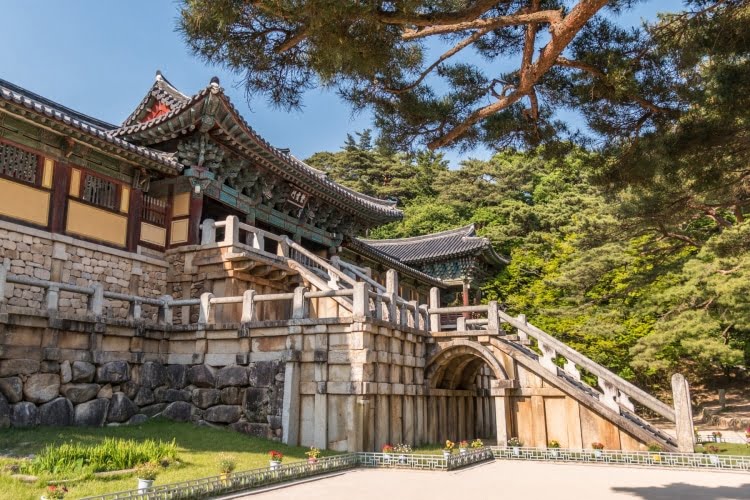
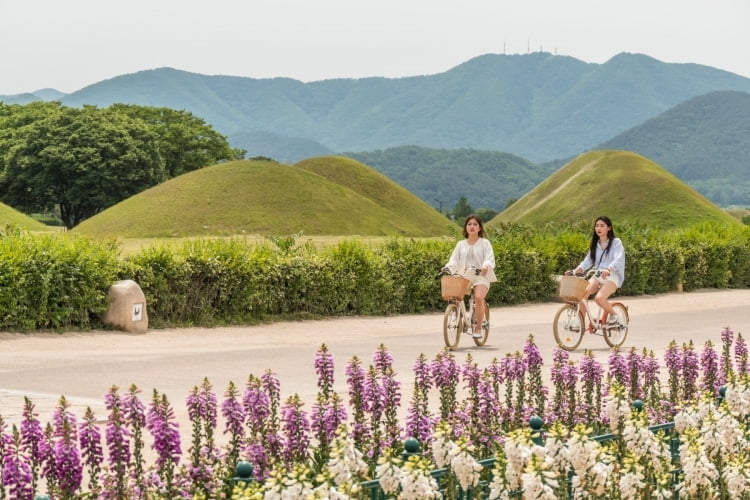
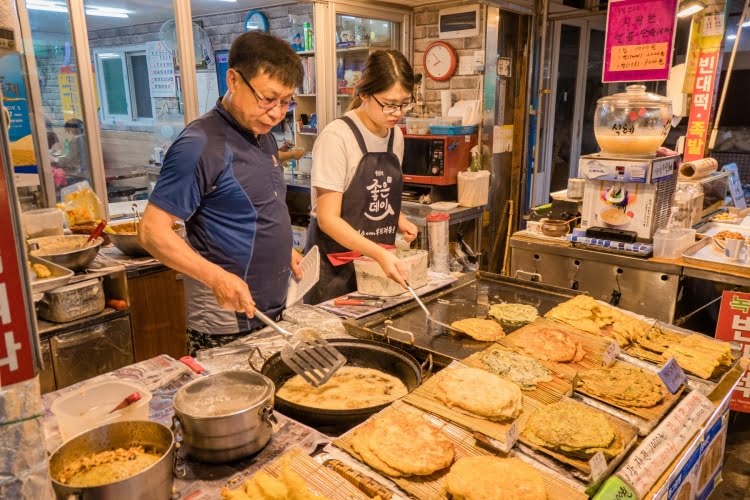



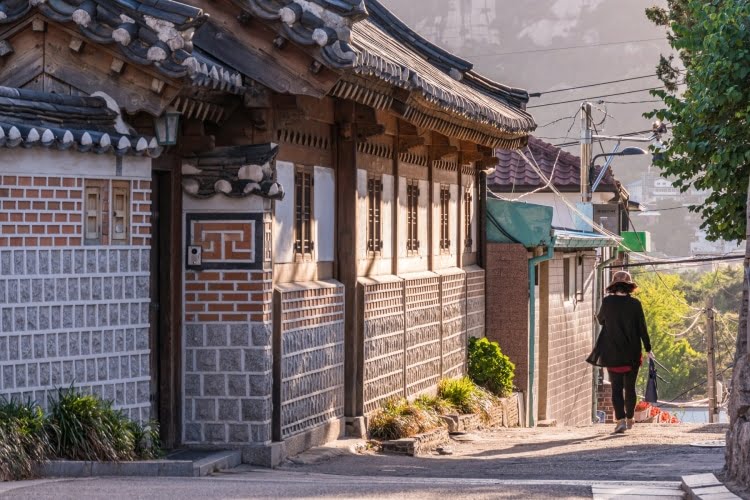

So, does Korea inspire you?
Did you like the article? share on Pinterest!
